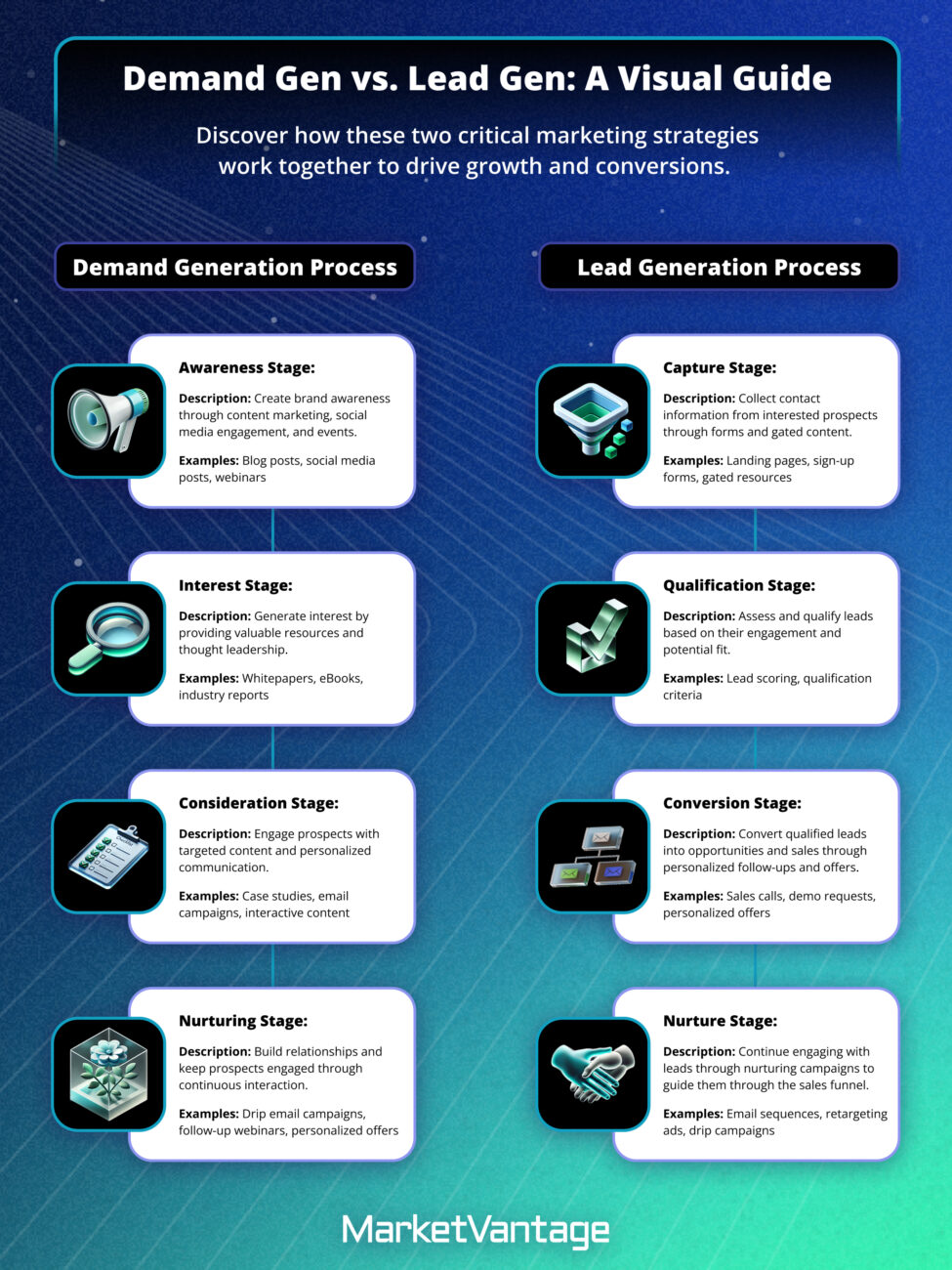
Demand Gen vs. Lead Gen: A Comparative Guide for B2B Marketing
In the ever-evolving landscape of B2B marketing, distinguishing between demand generation (demand gen) and lead generation (lead gen) is crucial for developing effective strategies. Both disciplines play vital roles in the marketing funnel, yet they serve distinct purposes. Understanding these differences and optimizing both strategies will be key to driving growth and achieving success. In this guide, we’ll explore the nuances of demand gen and lead gen, their interconnections, and best practices for maximizing their impact.

What is Demand Generation?
Demand generation is the process of creating awareness and interest in your product or service. Its primary aim is to build and nurture potential customers throughout their journey, from initial awareness to eventual conversion. Here are some core components:
- Content Marketing: Developing high-quality, relevant content that resonates with your target audience. This includes blog posts, whitepapers, eBooks, and case studies.
- Social Media Engagement: Using platforms like LinkedIn, Twitter, and Facebook to engage with potential customers, share valuable content, and build brand awareness.
- Email Marketing: Sending targeted emails to educate and inform your audience, keeping them engaged with your brand.
- Events and Webinars: Hosting events, webinars, and virtual conferences to interact with prospects and showcase your expertise.
By implementing these strategies, B2B entities can attract and engage a broader audience, ultimately generating demand and positioning themselves as industry leaders.
What is Lead Generation?
Lead generation focuses on capturing and qualifying potential customers who have expressed interest in your offerings. The goal is to gather contact information and convert these leads into sales opportunities. Key tactics include:
- Gated Content: Offering valuable resources, such as reports or eBooks, in exchange for contact details.
- Webinars: Conducting educational webinars to capture leads interested in learning more about your product or service.
- Landing Pages and Forms: Creating targeted landing pages with forms to collect lead information and facilitate easy sign-ups.
- Lead Magnets: Utilizing special offers, free trials, or demos to entice prospects to provide their contact information.
Effective lead gen tactics help build a pipeline of qualified leads, increasing the chances of converting prospects into paying customers.
Comparative Analysis: Demand Gen vs. Lead Gen
While demand gen and lead gen serve different functions, they are highly complementary:
- Demand Gen: Generates awareness and interest, attracting a broad audience.
- Lead Gen: Converts this audience into actionable leads.
Both strategies are essential for a robust marketing approach. Key metrics for demand gen include website traffic, social media engagement, and content downloads. Lead gen metrics focus on lead quality, conversion rates, and sales revenue.
Case Study: Consider Company X, which launched a demand gen campaign using thought leadership content, targeted social media ads, and strategic email marketing. This approach significantly boosted their website traffic and engagement. To capitalize on this interest, Company X implemented lead gen tactics like gated content and webinars, converting the engaged audience into qualified leads. This integrated approach led to improved conversion rates and revenue growth.
Moving Forward: Best Practices for B2B Entities
B2B entities must adapt their strategies to meet evolving challenges and opportunities. Here are some best practices for optimizing demand gen and lead gen:
- Embrace Personalization: Tailor content and messaging to resonate with specific audience segments. Use data and automation tools to deliver personalized experiences that drive engagement and conversions.
- Leverage Emerging Technologies: Stay ahead by incorporating technologies like artificial intelligence, chatbots, and predictive analytics. These tools can enhance lead scoring, customer segmentation, and campaign optimization.
- Nurture Leads Effectively: Implement lead nurturing campaigns to build relationships with prospects. Provide valuable content and personalized touchpoints to keep leads engaged throughout their journey.
- Measure and Analyze: Continuously monitor and analyze your demand gen and lead gen efforts. Use analytics tools to track performance, identify improvement areas, and make data-driven decisions.
Conclusion
Demand generation and lead generation are distinct yet interrelated disciplines in B2B marketing. Understanding their differences and leveraging their strengths is crucial. By integrating demand gen and lead gen strategies, B2B entities can drive growth, attract qualified leads, and increase revenue. Stay informed, adapt to emerging trends, and continuously refine your strategies to stay ahead in the competitive landscape.

Demand Gen vs. Lead Gen Key Difference
Demand Generation and Lead Generation are complementary strategies that, when used together, create a robust marketing funnel. Understanding their differences helps optimize your marketing efforts for better results. Download our chart that explains the key difference.




